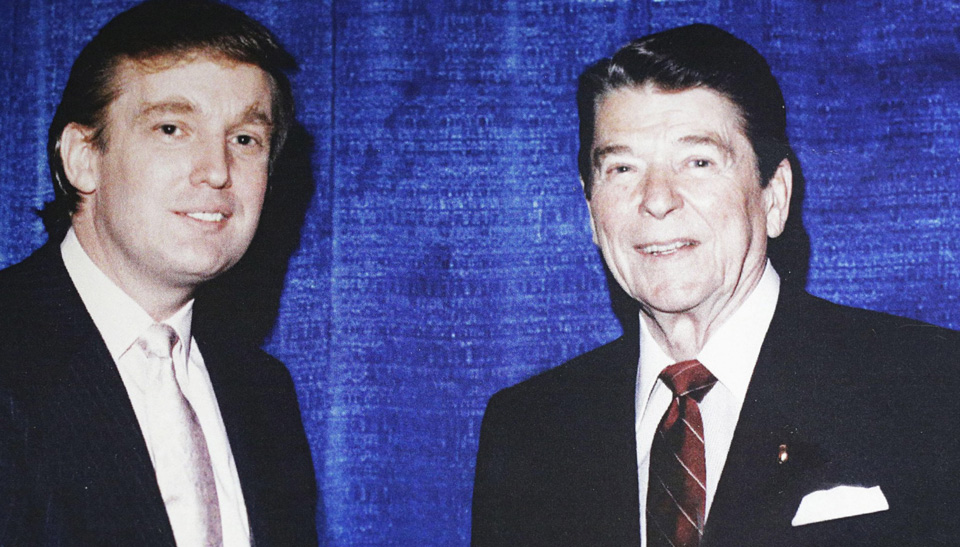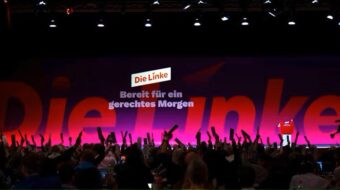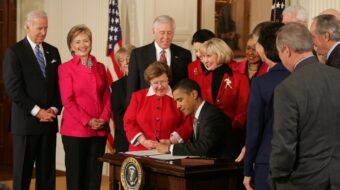
“It’s the economy, stupid.” That was political operative James Carville’s watchword for the staff of Bill Clinton’s presidential campaign back in 1992. Focus on the economy, that’s what matters in people’s lives. That’s what will get you votes. It was pretty good advice at the time.
A guy named Fred Engels said about as much in a more convoluted way back in the 1890s: “the final causes of all social changes and political revolutions are to be sought…not in the philosophy, but in the economics of each particular epoch.”
And if the Republican Party hadn’t put up such an extremist as Trump, we’d probably also be talking a lot more about the economy in this election. The two parties have put forward very different plans. One aims at building a base for broadly-shared growth, while the other is out to funnel more wealth and benefits toward the top. I think you know which is which.
But instead of talking about the vast economic chasm separating the two parties – and what that means in the lives of everyday people – we are left freshly aghast each morning at the latest outrageous thing uttered by the Donald. It’s really a shameful situation. Trump himself is of course to blame, but so is much of the mainstream media. Horserace antics and sensationalized reporting helps prompt more ad buys. The advertising departments of corporate media outlets have been some of the biggest winners from Citizens United.
As we enter the homestretch of this long campaign, and as the down-ticket races for Senate and the House become the place where interesting things can still happen, it’s worth taking a look at broad outlines of what the two parties have in mind when it comes to the economy. Because even if Trump goes down to defeat (an outcome looking more likely everyday), there are still thousands of GOP candidates and officials fanned out across this country who are pushing the same basic program as him.
Taxes: The 0.1 percent vs. the rest of us
Real job growth and income gains have been pretty scarce for most people over the last 15 years or so. From the first bubble-based recession in the stock market back in the early 2000s on up to the much bigger one that came with the collapse of housing and the financial system in 2008, most working class people haven’t been able to catch a break.
No matter what the Republicans say, it’s true that there’s been a recovery, of sorts, under Obama. But it’s also undeniable that the benefits of said recovery have been disproportionately enjoyed by those at the top. The data tell us that growth is happening, but the jobs and wage gains don’t yet seem to match. Not very many people feel the economic situation of their own family is back on solid ground yet.
That’s why the choice between the Dems and the GOP in this election is really an important one. Trump’s sexism, racism, and Islamophobia are already enough to turn many people off, but his party’s economic platform should really seal the deal.
The GOP nominee has been brooding for months over the gloomy state of the U.S. economy; he weaves a tale of a country in irreversible decline. He even titled his campaign book Crippled America. His party’s program for getting the country moving again though – for making it Great Again – is nothing more than the same old agenda of huge tax cuts for the super wealthy, trimming back regulation, and turning over control of trade to the billionaires of big business.
Trump is pledging to cut the number of tax brackets from seven to three with the rate on the top bracket dropping by more than six points, meaning the super rich will now be able to file more of their income under fewer (and lower) brackets at tax time. For the top 0.1 percent, this translates to tax avoidance to the tune of over $1 million a year. As for the rest of us, there’s not much to get excited about in the Trump tax plan.
Over the course of 10 years, there would be $6.2 trillion less for public investment in jobs, health care, education, and other priorities. Just as Donald has avoided paying for any of those things, he wants to make sure the rest of the billionaire class get off as well. Alan Auerbach, an economics professor at UC Berkeley was left stammering by the Republicans’ program for the economy. “The Trump plan is just this enormous tax cut that couldn’t be adopted,” he said. “I don’t even know to evaluate it.”
Clinton and the Democrats, meanwhile, are putting forward a plan that includes a “fair share surcharge” on people making over $5 million a year (only about 2 out of every 10,000 taxpayers). It asks the 0.1 percent at the top to chip in an extra $800,000 yearly on average.
The Dems also say they’ll raise capital gains taxes on short-term investors making plays on the stock market, close carried interest loopholes, and raise inheritance taxes on giant estates. All in all, it adds up to nearly half a billion dollars over the next decade. That’s a lot of money to put toward new green economy jobs, shoring up and expanding Social Security, and bringing in tuition-free college for working class families.
Infrastructure: The imaginary and the real
It’s been estimated that more than a trillion dollars is needed in infrastructure investments in the U.S. over the next ten years. Spending money in this category is a way to kick start the economy today while also tilling the soil for future growth. And even with all the chattering about the national debt, today’s super-low interest rates mean this the perfect time to make long-term investments.
The GOP and Trump say they are for infrastructure spending, but it’s hard to find many specifics on what they have in mind. Apart from Trumps’ so-called “America First Energy Plan” that would reverse all the clean energy rules of Obama’s Climate Action Plan, free up production of dirty coal, and restart the Keystone XL pipeline, it’s tough to find many solid infrastructure proposals.
On the Democratic side, Clinton promises a $275 billion infrastructure plan within her first 100 days. Reforming the tax system for businesses plus a new $25 billion infrastructure bank will make good down payments on what’s needed. The agenda includes traditional infrastructure projects like roads, bridges, water systems, and airports, but it also targets major growth in modern public transit systems, broadband Internet, and other technologies. It’s her biggest domestic policy proposal so far.
Clinton’s plan is still less than what’s needed, but it’s a start. Like the Affordable Care Act did for the fight for single payer, it gives us something to build from.
Trade: Trump is all talk
Trump’s bluster about unfair trade deals, stopping the TPP, and renegotiating NAFTA was exposed by his own big mouth at the last debate, when he said that “big companies” should be in charge of negotiating all our trade deals. He tries to talk a good talk to get working class voters, but his real trade agenda is to just turn over control to corporate America.
Republicans in Congress are of course on side with Trump on the issue, even if his way of talking about trade might sound unorthodox to what we’re used to hearing from them.
Clinton says she’s against the TPP now and will be when she’s president. The Bernie Sanders campaign deserves a lot of credit for keeping the TPP issue hot during the Democratic primary, and if Clinton wins, it will be up to labor and the broad coalition of people’s movements to keep her to that promise.
As for international trade itself, going back to the days of high tariff walls and sealed economies is neither feasible nor desirable. So Clinton’s proposal for a special “trade prosecutor” to enforce better trade standards is interesting and novel. She says this prosecutor will “end the abuse of our market, our workers, our people.” Time will tell whether this amounts to much, but it will probably fall to the movements to keep the pressure up after November 8th.
Beating Trump is not enough
Whether you look at taxes, infrastructure investment, or trade, there is a clear difference between the two campaigns when it comes to economics. One side promises more of the same old austerity and tax cuts for the super wealthy. The other at least holds out the potential for a very different future, one that is premised on more broad-based growth and a wider distribution of prosperity.
But just beating Trump on Election Day is not enough. If the Republican Party is still able to prevail in House, Senate, and state races across the country and hold onto the levers of power, they will stand in the way of everything the people’s movements hope to achieve. Fair share surcharges, big infrastructure plans, fairer trade – all of it will be blocked by the GOP. To keep them from throwing a wrench into the gears, they have to be defeated up and down the ballot.
Clinton’s quip about “Trumped-up Trickle Down Economics” might have gotten some chuckles on late night TV, but basically she got it right. The Republican Party is still selling the same old Reaganomics program wrapped up in the form of an orange demagogue.












Comments